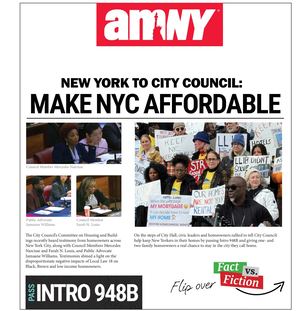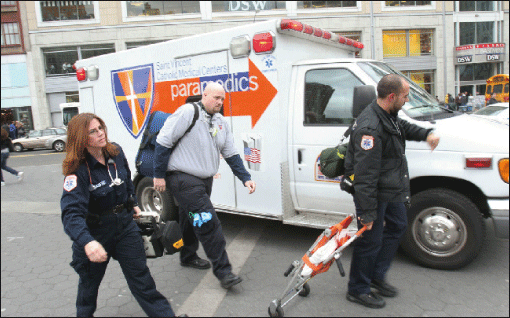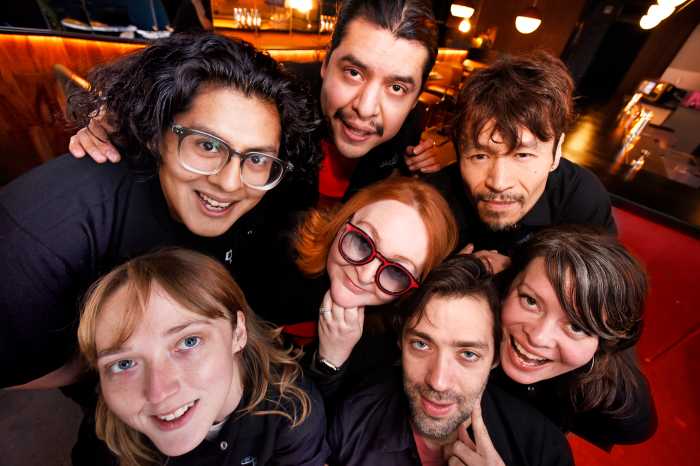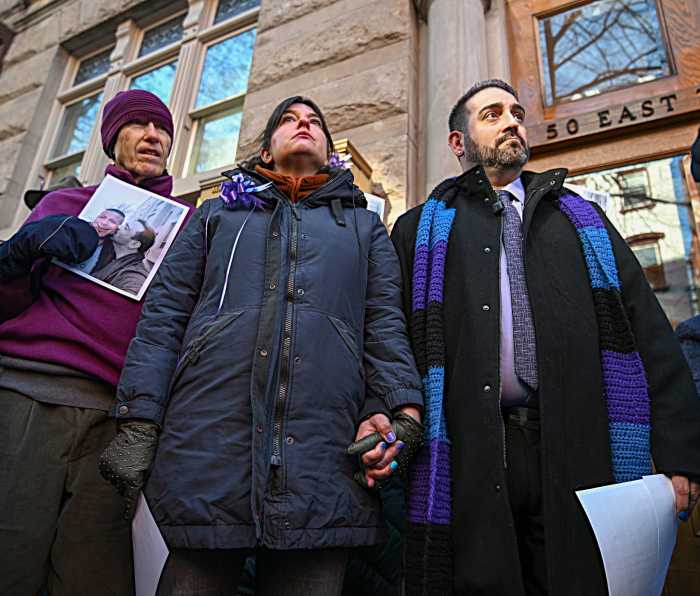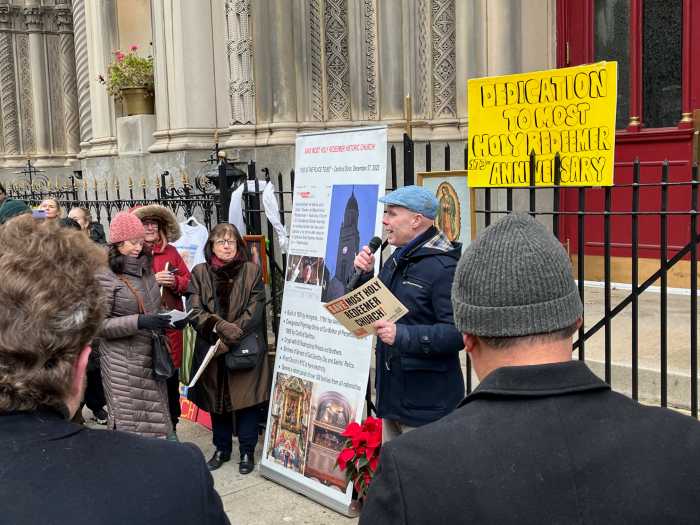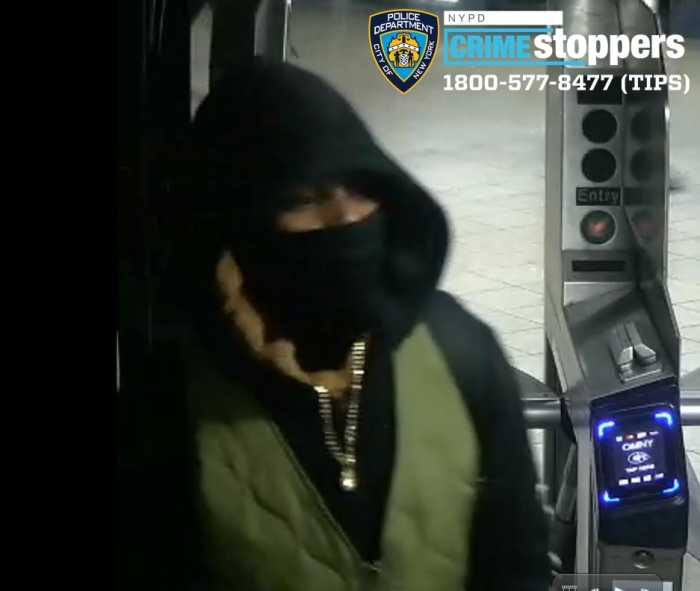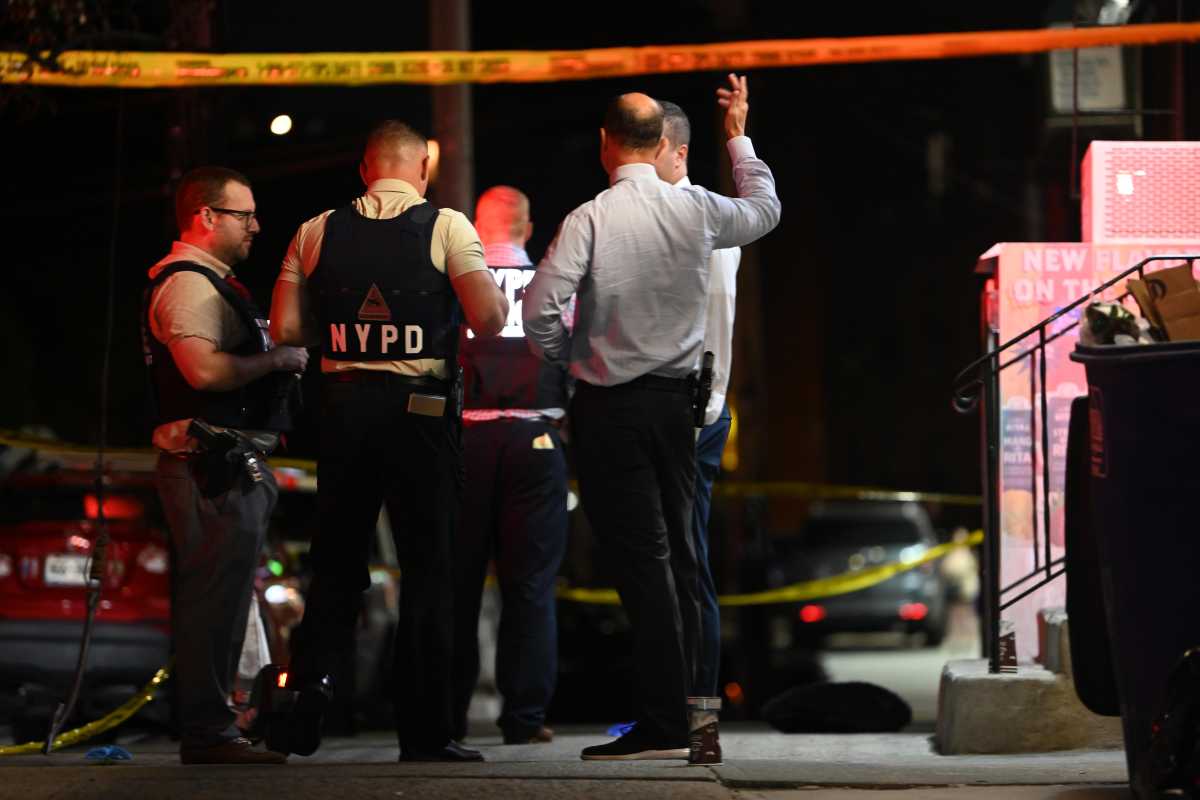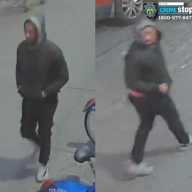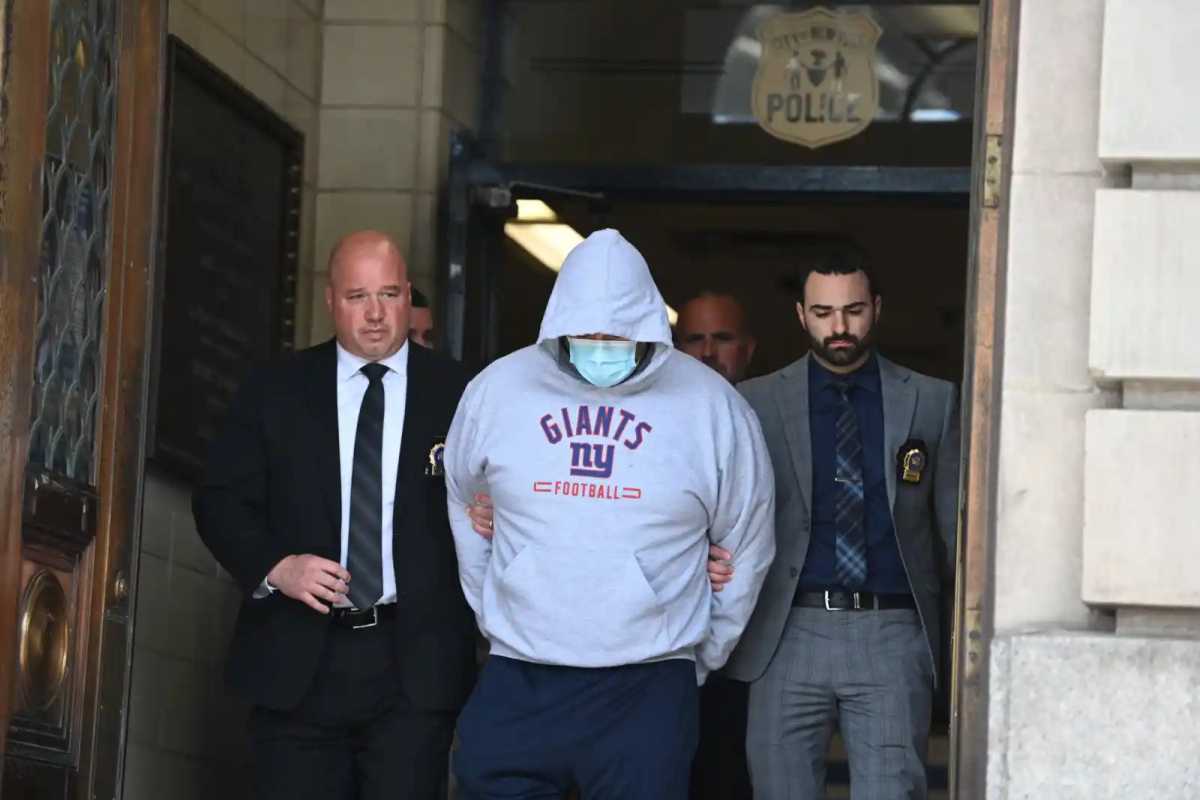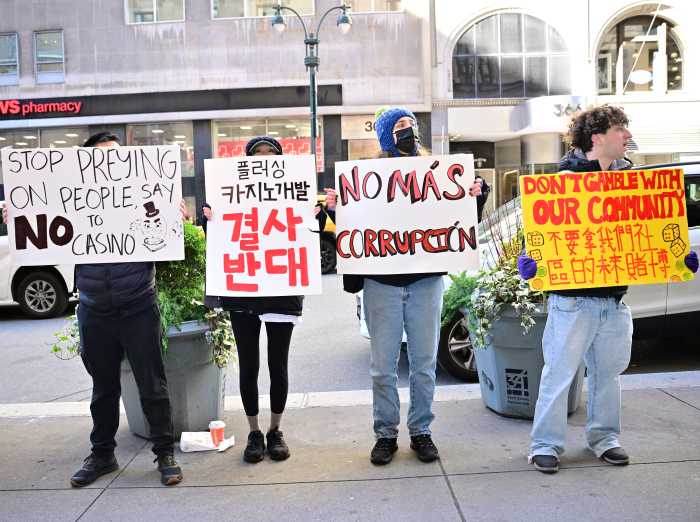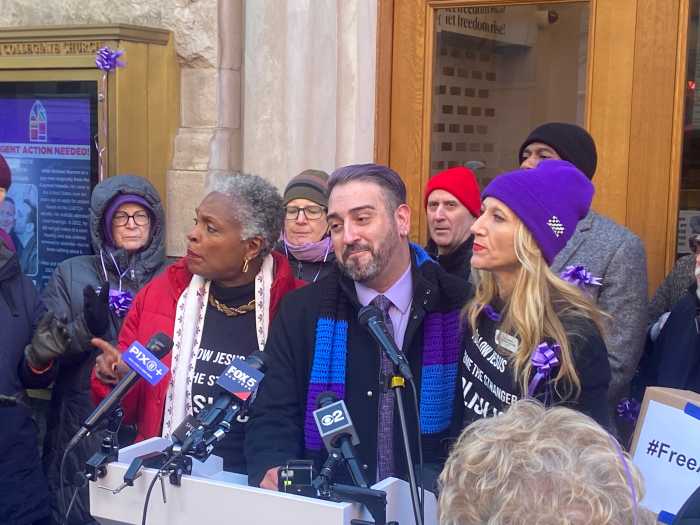By Jefferson Siegel
On the morning of Sept. 11, 2001, physicians, nurses and staff of St. Vincent’s Hospital lined Seventh Ave. S., watching as smoke from the terrorist attack blotted the Downtown sky. As the closest Level 1 trauma center, the hospital stood prepared for an influx of casualties, which never arrived.
The hospital’s emergency department was prepared for the worst at a moment’s notice. As a 24/7 operation, the E.D., by nature, is ready to cope with virtually any medical crisis presented by walk-ins and ambulance arrivals.
Currently the St. Vincent’s E.D. treats more than 58,000 people a year. As the city’s population grows, coupled with nearby hospital closings, the St. Vincent’s E.D. could be treating 70,000 patients a year in the coming years.
For severely ill or injured patients, medical care often begins before arrival at the E.D. St. Vincent’s has its own fleet of ambulances staffed by paramedics and emergency medical technicians.
On Friday afternoon two weeks ago, paramedics Marilyn Acevedo and Noel Duran sat at a prepositioned location in their “bus” waiting for a call. As traffic flowed by down Seventh Ave. S. at Bleecker St., Duran, 30, checked the computer screen, where calls are posted.
“You have days that you encounter the most enigmatic puzzles, and you have days with flu and colds,” he mused. Duran served in the Marines for four years and studied cellular biology in college. He’s been a paramedic for eight years. “I really enjoy my profession,” he said.
Acevedo, 44, also served in the Marines. A mother of three, she taught humanities at East Side Community High School in the East Village before becoming a paramedic three years ago.
“I love the job, even the intoxes,” she said of the frequent intoxication calls they get, especially on weekends. Paramedics answer an average of four to five calls per shift.
On the Uptown Q train platform at Union Square, Duran assessed the condition of the unconscious man.
Just before 3 p.m. their ambulance, designated “02-Victor,” had been sitting “10-89” — ready and waiting — when the Fire Department dispatcher sent out a call: an unconscious male, cardiac, difficulty breathing, on the uptown Q train platform of the Union Square subway station.
Flicking on the siren, Duran turned the ambulance east on Bleecker St. and hit midday traffic as it rolled up Sixth Ave. Duran pointed out that many drivers often fail to yield to an ambulance. Driving across 14th St., a UPS delivery truck in the left lane — with two red “Safety” flags hanging off its rear — drove in front of the ambulance for half a block before finally pulling over.
Arriving simultaneously with the paramedics were half a dozen firefighters from Engine 14 and a trio of police. The paramedics did a quick assessment of the man, now semiconscious, and placed an oxygen mask over his face. In an incongruous scene, a woman sat on a bench next to the homeless man, her nose buried in a book, somehow oblivious to the tumult.
Once above ground and in their rig, the paramedics started an intravenous line. They attached 12 electrodes to various parts of the man’s chest to measure heart rate. They checked his blood sugar, lungs, eyes, skin and temperature. Vital signs were transmitted back to the hospital.
Within minutes of leaving Union Square, “02-Victor” backed into the ambulance bay on Seventh Ave. S. Acevedo and Duran helped an admitting nurse check the man in and filed the ever-present paperwork. It was the end of a long shift but Acevedo looked forward to tomorrow.
“This job is my sanity because I get to use my mind,” she said.
On this Friday afternoon the St. Vincent’s Emergency Department bore only a faint resemblance to a familiar television drama. There were no staffers running down halls barking orders, although the treatment areas were full and several stretchers with patients sat in an aisle. The atmosphere was one of control, almost sedate.
At a table along the center wall, several physicians and nurses sat filling out patient charts. Other nurses in scrubs moved among the stretchers, dispensing medicines, checking monitors and adjusting IV lines.
Dr. Daniel Egan, attending physician of the emergency department, is board certified in emergency medicine, as are all St. Vincent’s physicians who work in the department. He had just completed an assessment of a patient who had just arrived, a 64-year-old male complaining of shortness of breath and a rapid heartbeat.
Dr. Egan strode into the single-bed trauma room at the far end of the E.D. He had diagnosed the patient with an irregular heartbeat that needed to be regulated. He chose to administer adenosine, a drug that would lower blood pressure and dilate the arteries. Like rebooting a computer, adenosine would slow the heart close to stopping, then allow it to return to normal rhythm.
The patient, a physician, was familiar with the procedure.
Dr. Daniel Egan, the emergency department’s attending physician, left, entered notes in a patient’s chart on a computer after performing a procedure. He is sitting at the emergency department’s central station.
“You’re going to get a flush, warm feeling,” Dr. Egan calmly advised his patient as he checked vital signs on an overhead monitor. A nurse inserted a syringe into the IV line. “Slow, deep breaths, then two seconds of pain,” Dr. Egan said as the drug was administered. The patient gasped, coughed, then, “You’re out of it,” Dr. Egan said as the patient caught his breath. On the overhead monitor the heartbeat showed normal, regular rhythms.
After several more minutes, the patient, born in St. Vincent’s Hospital, said, “I feel great.” Dr. Egan, standing at a computer terminal to document the procedure, then wrote orders for the patient’s care.
St. Vincent’s employs 140 physicians in the hospital; a total of 1,000 are on staff, including outside physicians with admitting privileges. Projecting a 5 percent annual growth rate in the use of the E.D., St. Vincent’s last year opened a new area adjacent to the E.D. called the “Fast Track.” Fast Track was part of the E.D.’s recent renovation, adding a unit for patients with less complex problems who can be treated promptly with fewer resources.
Almost a third of patients coming to the E.D. are now seen in the Fast Track area, according to Dr. Carol Barsky, who has been chairperson of the department of emergency medicine and clinical director of the emergency department since July 2005. This new area of the E.D. has 10 rooms and a dedicated X-ray machine, whose scans can be viewed immediately on a computer monitor.
“We are, all together, working to create a great clinical environment for the patient,” Dr. Barsky said during a tour of Fast Track. “We’re really responsible for patient care from the moment a 911 call goes out until somebody’s admitted or discharged.”
In addition to her administrative tasks, Dr. Barsky has hands-on duties in patient care, working a regularly scheduled shift, as do heads of the other departments.
“You need to do that to be a good chairperson, you need to really live your clinical life.” Dr. Barsky, who studied at the Mayo Clinic, works at least 60 hours a week and is always on call.
“Part of what we learn as emergency physicians is how to take care of individual patients, how to take care of mass-casualty events, how to take care of large-scale disasters and also how to understand what people need, when and why, so that our resources are focused on what a patient truly needs,” Dr. Barsky said.
To maintain quality care, an independent auditing agency surveys discharged patients to solicit feedback, which Dr. Barsky and other department heads review at weekly meetings.
When the tragic shooting of two Sixth Precinct auxiliary police officers on March 14 occurred, St. Vincent’s staffers undertook heroic measures in providing care. In a letter thanking Dr. Barsky, Deputy Inspector Theresa Shortell, Sixth Precinct commanding officer, described the E.D. staffer’s efforts as “an inspiring act of compassion during a chaotic and trying time.”
Walking out of the Fast Track area, Dr. Barsky paused at the door.
“Emergency departments are the last bastion of democratic care,” she said, before entering the larger E.D., where another patient had just arrived and was being triaged.
